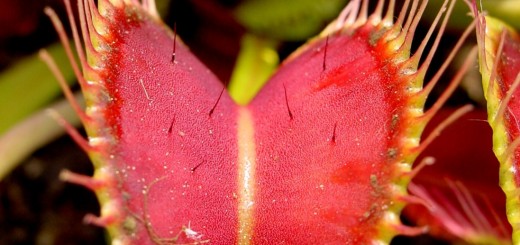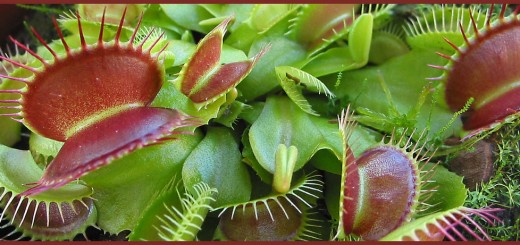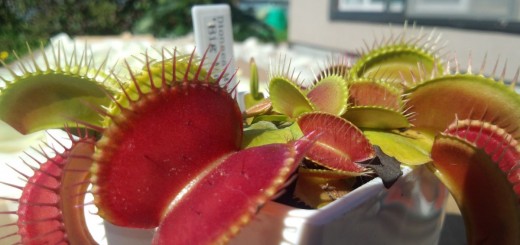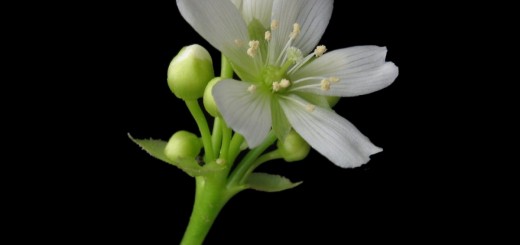It’s Muscipula chow time!

Hypothesis : Total three musketeer complex all for one and one for all, i think when one Dionaea muscipula, commonly known as venus flytrap, eats they all eat.I believe it’s through some kind of nutrient transference that has to do with the previous fly traps that have died and been buried by new growth for the sole purpose to store nutrients for the surviving members of the plant.
Digestion is the fourth step in the hunting cycle. The digestive system is one of the most alluring aspects of the venus flytrap because it can’t really be observed in action… or can it?
Like a character out of a sci-fi novel this plant has a taste for flesh.The Venus Flytrap , has a carnivorous appetite that can be fed by the common house fly.
What’s going on with the venus fly trap when it comes down to how it’s digestion of bug flesh is similar to our own digestive systems.The acids in the venus flytrap break down the bug much like our own stomachs use of acid. All of our systems are consuming outside nutrient to fill a void that our own bodies don’t produce. Or they don’t have access to in the case of the venus fly trap. This carnivorous plant exhibits a unique system by which it attracts, kills, digests and absorbs its prey for Nitrogen and other nutrients due to growing in very low nutrient habitats. It’s such an efficient hunter that it literally doesn’t even have to move to exhibit its advanced skills by which it attracts, kills, digests and absorbs its prey. Can you imagine having the time for that?
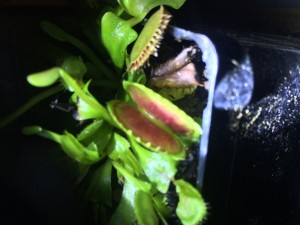
“The Venus Flytrap,” Darwin wrote in 1875, “is the most wonderful plant in the world.” and for good reason.
The venus fly trap “is one of the most mysterious plants on earth” because over a hundred and forty years ago ever since darwin stated how wonderful it is, people have been trying to figure out how this plant turned into a creature and how it works.
The venus flytrap Digestive system comprises of teeth camouflaged leaves that lock together, digestive juices to break up the insect and some trigger hairs that activate a 20 second countdown to chomp timer, if the trigger is set off a second time during that 20 second countdown it closes on its prey almost instantly. The trap has been effective in catching a meal.
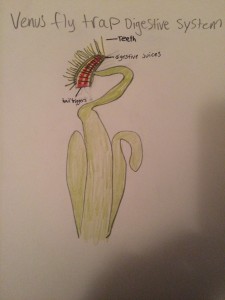
The venus flytrap Digestive system comprises of teeth camouflaged leaves that lock together, digestive juices to break up the insect and some trigger hairs that activate a 20 second countdown to chomp timer, if the trigger is set off a second time during that 20 second countdown it closes on its prey almost instantly. The trap has effectively become an external stomach and can begin producing enzymes to break down first the exoskeleton of the bug, chitin, then the nitrogen-rich blood known as hemolymph. Absorption of protein and minerals is complete within a week depending on the size of the insect. The trap opens once satisfied with it’s meal and lies in wait for the next poor bug to cross it’s path. Not fully dissolved, the remains of the bug have become shadow skeleton to be blown away by the wind.

The way the Venus fly trap acts as a multi headed hydra with a common base and external stomachs it stands to reason that the nutrients gained are distributed throughout the plant. Similar to how photosynthesis process of creating energy benefits the entire plant not just a single leaf.
- Bibliography
- Scala, K. Iot , F. E. Semersky , D. W. Schwab . 1969. digestive Secretion of Dionaea muscipula (Venus’s-Flytrap). Plant physiology (**Edition**) [Internet]. [**Last Updated**, cited 04/20/16] **Journal Info**. Available from: http://www.ncbi.nlm.nih.gov/pmc/articles/PMC396093/pdf/plntphys00208-0049.pdf
Wynne Parry . 2011 Sept 05. How the venus flytrap kills and digests its prey [Internet]. **Edition**. Olympia(**State**):LiveScience; [**Last Updated**, cited 04/20/16] . Available from: http://www.livescience.com/15910-venus-flytrap-carnivorous.html
Cara Clarke . **Date of Publication**. How does a venus flytrap trap flies [Internet]. **Edition**. **City**(**State**):**Publisher**; [**Last Updated**, cited 4/20/2016] . Available from: http://homeguides.sfgate.com/venus-flytrap-trap-flies-74657.html
Alexander G. Volkov, Monique-Renée Pinnocka, , Dennell C. Lowe, Ma’Resha S. Gay , Vladislav S. Markinb . 2011. Complete hunting cycle of Dionaea muscipula: Consecutive steps and their electrical properties. Journal of Plant physiology (**Edition**) [Internet]. [**Last Updated**, cited 2016 apr 20] Vol 168. Available from: http://www.sciencedirect.com.evergreen.idm.oclc.org/science/article/pii/S0176161710002683
Scheerer U, Kruse J, Burzlaff T, Honsel A, , Ghirardo A, Kreuzer I, Schnitzler JP, Alfarraj S, Kreuzwieser J1, , Rennenberg H., Hedrich R, Georgiev P, . 2014. The Venus flytrap attracts insects by the release of volatile organic compounds.. US National Library of Medicine National Institute of Health (**Edition**) [Internet]. [**Last Updated**, cited 04/20/16] **Journal Info**. Available from: http://www.ncbi.nlm.nih.gov/pubmed/24420576
Philip A. Rea . 1983. The influence of secretion elicitors and other effectors of H+ efflux on carboxylate synthesis by the trap lobes of Dionaea muscipula ellis (venus’s flytrap). **Journal** (**Edition**) [Internet]. [**Last Updated**, cited 2016 Apr 20] Vol. 32. Available from: http://www.sciencedirect.com.evergreen.idm.oclc.org/science/article/pii/0304421183901116
